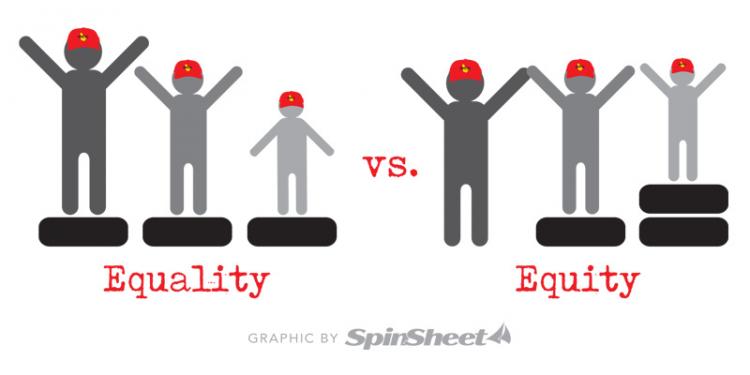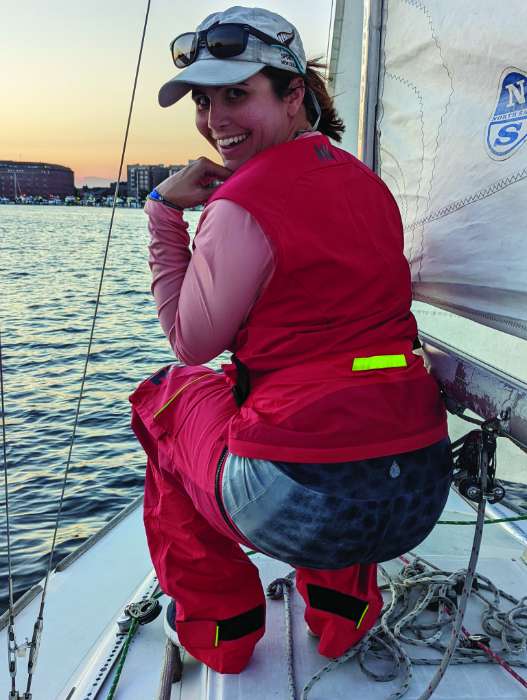You’ve Heard About Pay Equity—Let’s Talk to Racing Sailors About “Pee Equity”
How many times have you been out sailing or racing, looked up, and there’s some guy leaning off the back or side of the boat watering the Bay? Most of the time you may look in another direction or maybe feel a bit embarrassed. If you’re a particular sailor in Hampton Roads, you may yell, “Look! It’s like a penis, only smaller!” But how many times have you seen a woman doing this? Chances are not a lot, if ever.
This is an issue of equitable access to the normal and healthy bodily function of removing wastewater, also known as peeing. If you’re unfamiliar with the term equity, I’ve included this helpful diagram below.
 According to the George Washington University Milken School of Public Health, equality means each individual or group of people is given the same resources or opportunities. Equity recognizes that each person has different circumstances and allocates the exact resources and opportunities needed to reach an equal outcome.
According to the George Washington University Milken School of Public Health, equality means each individual or group of people is given the same resources or opportunities. Equity recognizes that each person has different circumstances and allocates the exact resources and opportunities needed to reach an equal outcome.
Equity essentially allows those with historic disadvantages the support they need to overcome them. If you were able to read the excellent article titled “Bridging Sailing’s Great Divide” in the Spring 2022 issue of Sailing World by Kelly McGlynn, you are familiar with the issue of women’s equity and equality in competitive sailboat racing. (If you haven’t read the article, I highly recommend it).
Allowing women to complete normal bodily functions during a race day or while on a long cruise is a small but very important step to increasing gender parity. In particular, I’m talking about peeing when you’re on a boat, or as I’m calling it: pee equity. You may be familiar with pay equity issues in other sports, which has been highly publicized recently through the US Women’s National Soccer Team. As the vast majority of us on a sailing racecourse are not being paid to be there, I think an essential conversation needs to be had around equitable access to peeing during a sailing event.
Men folk, I have always been jealous that you can just “go” at almost any time during a race day. As a woman, we may literally have to plan our day around bathroom uses, depending on the situation. I sail on boats where there is a true head with a holding tank but also on boats where the head is a bucket. I need to inform you that in a racing situation, neither are ideal. If it’s rough out, going below to use the head may mean I need to take off layers of gear, taking me off the rail for a significant amount of time, losing my eyes and hands in case of a maneuver. Also, it will probably be gross unless it’s completely flat water.
The obvious advantage of a head below is privacy, and this is where I need to say I am fully aware that this conversation may be icky for a lot of teams. Let me tell you, if you sail with women (which you should), they have thought about it and talked about it with other female sailors.
Last year, I participated in the Annapolis to Newport Race for the first time, and I could not stand leaving my watch to use the head below. Instead, I found a way that works for this particular race boat and continued to adapt this method to the other three boats on which I sail. If you are grossed out by bathroom talk, skip this next paragraph.
First, I go to the transom of the boat. For ocean racing, I clip in using my offshore lifejacket and tether. With my Helly Hansen foul weather pants on (affectionately known as bibs), I open the drop seat (more on that below), pull down my shorts or leggings and underwear a few inches. Then, I sit on the top rail or hold onto the back stay and do a squat hold over the water and make my liquid deposit, trying to aim away from fiberglass.

Completing this does take discretion on where the boat is in relation to other boats as well as other crew members to give the illusion of privacy for your rear end. I have been very fortunate to sail with crews that are supportive of me doing this because it makes me equal with the men. One of my teams has gone so far as to say that if the girls can’t pee off the back, the guys can’t either. I feel so supported by this team; I actually think it makes us better!
Another aspect of pee equity is women’s sailing gear. In this instance, I’m not talking about champagne conditions where all I need are some shorts and a tech tee. On days that are wet, wearing foul weather gear can be a hindrance to using the head. If you have a PFD, jacket, bibs, and under layers on, you may have to basically get naked to use the head. Enter: the drop seat. On some brands of foul weather pants, there is a handy zipper that opens the lower back/butt area to allow for leaving layers on the upper body while using the head. If you’re a female racer, you may have just said “duh,” but I have spoken to many men recently that didn’t know that was a thing—including an employee at a sailing apparel shop.
Anyway, the drop seat is an essential tool in pee equity. I want to give a shout out to Helly Hansen for their excellent design for women’s bibs, while adding I am in no way benefitting from this endorsement (although if I can get a discount, I wouldn’t say “no”). There are brands that have different designs, but they’re just not as good. I look forward to seeing this evolution continue as we move the discussion about women in competitive racing forward.
Coming to my conclusion, I want to emphasize that pee equity is not only a gender parity issue but also a safety issue. If women know that they will not be able to pee safely for some time, they will purposely dehydrate themselves causing all kinds of short- and long-term problems for a crew. From increased fatigue and likelihood of heat stroke to kidney failure, dehydration is dangerous for a racing crew.
I encourage every racing and distance cruising crew to have the conversation about comfort levels and logistics for using the head that leads to a holding tank vs. the head that is surrounding any vessel afloat. This conversation needs to be a practical discussion about a bodily process that everyone will do at some point. You might as well make it equitable to pee on your boat.
About the Author: Active racing sailor Jordan Stock is a SpinSheet Century Club and Racing Team member as well as one of the founders of the Downtown Sailing Center’s Women on Water (WOW!) program.




